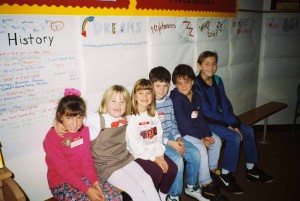Ds Awareness Month Story- Erin

INCLUSION REALLY IS GOOD TEACHING, NOT SPECIAL TEACHING
Original Version Written Winter, 1992
A year ago we were beginning our discussions with school personnel concerning our desire to have our daughter totally included in the same elementary school her brother attends. This is not an exclusive private school, just a public school that happens to be in our neighborhood. All of the other children who live in our area go to it unless their parents have made private choices. Then why did we have several meetings to decide if our daughter would be “allowed” to attend this school?
Our daughter has one of those labels that the state and federal government say make her eligible for special services. She has a mild hearing impairment, but she is not H.H. (Hearing Handicapped). She has difficulty learning the same way as other children, but she is not L.D. (Learning Disabled). With all of her multiple disabilities she could easily be M.H. (Multiple Handicapped), but she’s not labeled that either. The school district has decided that she best fits into the category of D.H. (Developmentally Handicapped) which is the state of Ohio’s label. The assumption is that if our daughter is put into the D.H. classroom, she can be made ready to rejoin her community in controlled implements at a later date.
Since our daughter was never made ready to join our family and was an equal, fully participating member from the day she was born, that idea seemed strange. So we decided to pursue a different option – inclusion. That brings us back to the reason for all of the meetings.
Fortunately our school district employs some very innovative and caring individuals who have been willing to take a risk, be creative, bend the rules, and do what is right. Together we have worked on a vision of how things could be.
This has not been an easy process. It is difficult to leave old “good ideas” to explore new dreams and possibilities. Job descriptions have needed to change. Some very well-meaning people have not wanted to give up control of our daughter. Set-up integration based on “ability” is not quite the same as natural inclusion that is enhanced and supported. We have all learned a lot, especially our daughter.
Inclusion as it applies to education requires flexibility, creativity, cooperative theories, collaboration, commitment, and risk – all of the requirements of good teaching, not special teaching. It is about adults supporting other adults and children, children supporting other children and adults, and everyone learning how to problem solve together. It is about discovering the strengths and gifts in each of us.
Discussions have begun again for next year, but they are not about whether or not our daughter will be allowed to attend our neighborhood school and be in the class she would be in if no label existed. Our daughter is welcome at the school. She will be following her classmates and friends to the next grade; will hopefully have unlimited opportunities to learn; will receive supports when needed from adults, peers, and technology; and will be able to offer her own talents to share with and to teach others.
Taken from Reflections of Erin, The Importance of Belonging, Relationships, and Learning with Each Other,
By Barbara McKenzie, Design by Chris McKenzie, Art of Possibility Press, 2008
DSACO note: This story was originally written by Barbara McKenzie in 1992. Although time as passed, the message of advocating for inclusive schools and classrooms remains an issue within some school districts today.

